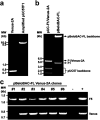Use of a Bacterial Artificial Chromosome to Generate Recombinant SARS-CoV-2 Expressing Robust Levels of Reporter Genes
- PMID: 36342302
- PMCID: PMC9769592
- DOI: 10.1128/spectrum.02732-22
Use of a Bacterial Artificial Chromosome to Generate Recombinant SARS-CoV-2 Expressing Robust Levels of Reporter Genes
Abstract
Reporter-expressing recombinant virus represents an excellent option and a powerful tool to investigate, among others, viral infection, pathogenicity, and transmission, as well as to identify therapeutic compounds that inhibit viral infection and prophylactic vaccines. To combat the ongoing coronavirus disease 2019 (COVID-19) pandemic, we have established a robust bacterial artificial chromosome (BAC)-based reverse genetics (RG) system to rapidly generate recombinant severe acute respiratory syndrome coronavirus 2 (rSARS-CoV-2) to study the contribution of viral proteins in viral pathogenesis. In addition, we have engineered reporter-expressing recombinant viruses in which we placed the reporter genes upstream of the viral nucleocapsid (N) gene to promote high levels of reporter gene expression, which facilitates the study of SARS-CoV-2 in vitro and in vivo. To date, we have shared our BAC-based RG system with more than 100 laboratories around the world, which has helped to expedite investigations with SARS-CoV-2. However, genetic manipulation of the BAC containing the entire SARS-CoV-2 genome (~30,000 nt) is challenging. Herein, we provide the technical details to engineer rSARS-CoV-2 using the BAC-based RG approach. We describe (i) assembly of the full-length (FL) SARS-CoV-2 genome sequences into the empty pBeloBAC, (ii) verification of pBeloBAC-FL, (iii) cloning of a Venus reporter gene into pBeloBAC-FL, and (iv) recovery of the Venus-expressing rSARS-CoV-2. By following this protocol, researchers with knowledge of basic molecular biology and gene engineering techniques will be able to generate wild-type (WT) and reporter-expressing rSARS-CoV-2. IMPORTANCE We have established a bacterial artificial chromosome (BAC)-based RG system to generate recombinant severe acute respiratory syndrome coronavirus 2 (rSARS-CoV-2) and to engineer reporter-expressing recombinant viruses to assess viral infection in vitro and in vivo. To date, we have shared our BAC-based RG system with more than 100 laboratories around the world, which has helped to expedite investigations with SARS-CoV-2. However, genetic manipulation of the BAC containing the full-length SARS-CoV-2 genome of ~30,000 nucleotides is challenging. Here, we provide all the detailed experimental steps required for the successful generation of wild-type (WT) recombinant SARS-CoV-2 (rSARS-CoV-2). Likewise, we provide a comprehensive protocol on how to generate and rescue rSARS-CoV-2 expressing high levels of a Venus fluorescent reporter gene from the locus of the viral nucleocapsid (N) protein. By following these protocols, researchers with basic knowledge in molecular biology will be able to generate WT and Venus-expressing rSARS-CoV-2 within 40 days.
Keywords: BAC; COVID-19; SARS-CoV-2; bacterial artificial chromosome; coronavirus; pBeloBAC; recombinant virus; reporter genes; reverse genetics.
Conflict of interest statement
The authors declare a conflict of interest. C.Y. and L.M.-S. are co-inventors on a patent application directed to reverse genetics approaches to generate recombinant SARS-CoV-2.
Figures






Similar articles
-
Rescue of SARS-CoV-2 from a Single Bacterial Artificial Chromosome.mBio. 2020 Sep 25;11(5):e02168-20. doi: 10.1128/mBio.02168-20. mBio. 2020. PMID: 32978313 Free PMC article.
-
Bacterial Artificial Chromosome Reverse Genetics Approaches for SARS-CoV-2.Methods Mol Biol. 2024;2733:133-153. doi: 10.1007/978-1-0716-3533-9_9. Methods Mol Biol. 2024. PMID: 38064031
-
Monitoring SARS-CoV-2 Infection Using a Double Reporter-Expressing Virus.Microbiol Spectr. 2022 Oct 26;10(5):e0237922. doi: 10.1128/spectrum.02379-22. Epub 2022 Aug 18. Microbiol Spectr. 2022. PMID: 35980204 Free PMC article.
-
Engineering SARS-CoV-2 using a reverse genetic system.Nat Protoc. 2021 Mar;16(3):1761-1784. doi: 10.1038/s41596-021-00491-8. Epub 2021 Jan 29. Nat Protoc. 2021. PMID: 33514944 Free PMC article. Review.
-
Reverse genetic systems of SARS-CoV-2 for antiviral research.Antiviral Res. 2023 Feb;210:105486. doi: 10.1016/j.antiviral.2022.105486. Epub 2022 Dec 22. Antiviral Res. 2023. PMID: 36657881 Free PMC article. Review.
Cited by
-
Transmissible SARS-CoV-2 variants with resistance to clinical protease inhibitors.Sci Adv. 2023 Mar 29;9(13):eade8778. doi: 10.1126/sciadv.ade8778. Epub 2023 Mar 29. Sci Adv. 2023. PMID: 36989354 Free PMC article.
-
Transmissible SARS-CoV-2 variants with resistance to clinical protease inhibitors.bioRxiv [Preprint]. 2022 Dec 26:2022.08.07.503099. doi: 10.1101/2022.08.07.503099. bioRxiv. 2022. Update in: Sci Adv. 2023 Mar 29;9(13):eade8778. doi: 10.1126/sciadv.ade8778. PMID: 35982678 Free PMC article. Updated. Preprint.
-
Engineering recombinant replication-competent bluetongue viruses expressing reporter genes for in vitro and non-invasive in vivo studies.Microbiol Spectr. 2024 Mar 5;12(3):e0249323. doi: 10.1128/spectrum.02493-23. Epub 2024 Feb 14. Microbiol Spectr. 2024. PMID: 38353566 Free PMC article.
References
-
- Liu DX, Liang JQ, Fung TS. 2021. Human coronavirus-229E, -OC43, -NL63, and -HKU1 (Coronaviridae), p 428–440. In Bamford DH, Zuckerman M (ed), Encyclopedia of virology. Elsevier, Amsterdam, The Netherlands.
Publication types
MeSH terms
Substances
Grants and funding
LinkOut - more resources
Full Text Sources
Medical
Research Materials
Miscellaneous

